Mastering Rock and Gem Identification Techniques
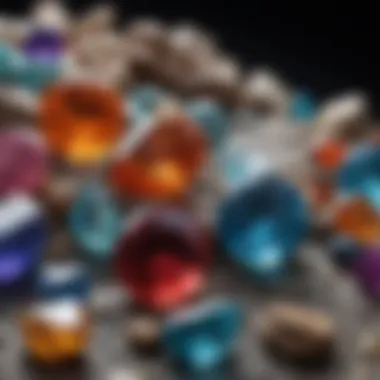
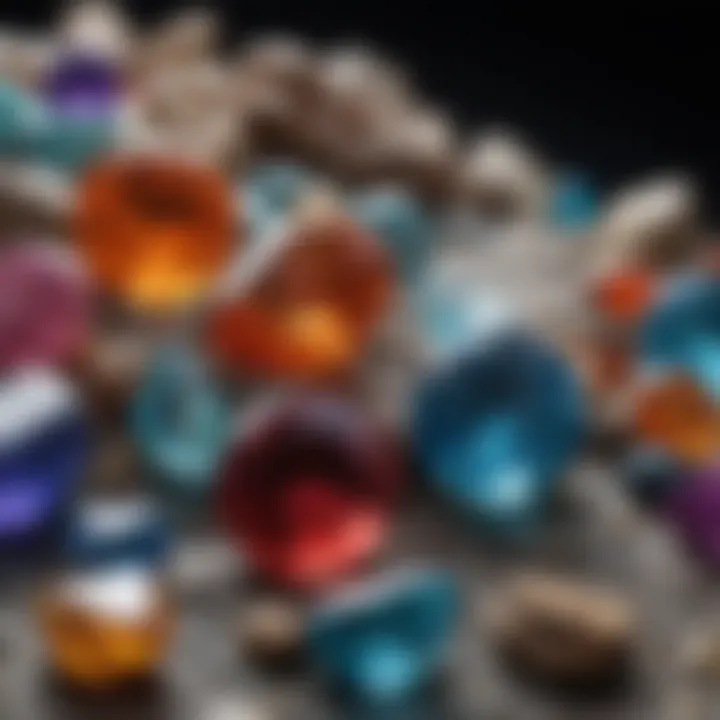
Intro
Embarking on the journey of identifying rocks and gems is like stepping into a treasure hunt where the earth itself is the canvas. For both newbies and seasoned enthusiasts, understanding the basics of rock and gem identification opens up a whole new world rich with history, science, and beauty.
Rocks and gems tell tales of our planet's past, shaped over millions of years by geological forces. By learning how to identify these natural wonders, one not only enhances their collecting skills but also gains a deeper appreciation for the artistry found in nature. In this guide, we’ll explore essential techniques, tools, and insights to help you uncover the mysteries of various mineral specimens.
Featured Collectible of the Month
Overview
This month, we’re shining a spotlight on the magnificent Amethyst, a beloved choice among collectors and gem enthusiasts. This striking purple quartz has captivated people for centuries and is renowned for its rich color and clarity. Amethyst is not only stunning to behold but also boasts a fascinating range of cultural significances from ancient times to the present.
Historical Significance
Tracing back to Ancient Greece, Amethyst was believed to ward off intoxication, with the name itself deriving from the Greek word "amethystos," meaning "not intoxicated." Ancient royalty adorned themselves with this gem, convinced that it held powerful protective properties. Today, Amethyst continues to be a popular gemstone in jewelry, valued not just for its beauty but also for its historical allure.
Identification Techniques
Identifying rocks and gems effectively requires a good eye and a methodical approach. Below, we detail some basic yet effective techniques to sharpen your identification skills.
Visual Characteristics
Rocks and gems often present a variety of features that can help in their identification. Look for:
- Color: While hue is the first thing noticeable, don’t rely solely on this; variations can exist based on impurities.
- Luster: Gems may shine differently; they can be glassy, dull, metallic, or silk-like.
- Crystal Form: The internal structure can indicate its classification.
- Hardness: Using the Mohs scale, you can compare scratch resistance against known minerals.
- Transparency: This can vary from completely clear to opaque, which can be a clue to its identity.
Resources for Identification
Several resources can aid in your identification quest:
- Books: Guides like "Rocks and Minerals" by Charles A. Sorrell provide comprehensive insight into various types of stones.
- Online Databases: Websites like Wikipedia and Britannica have extensive articles on minerals and their properties.
- Community Forums: Engaging in platforms such as Reddit or specialized Facebook groups can offer support, advice, and shared experiences with fellow collectors.
"Understanding the characteristics and properties of rocks and gems can enhance your collecting experience, making it both enjoyable and educational."
By grasping these foundational concepts and utilizing available resources, you can embark on your path to becoming a proficient rock and gem identifier. Stay curious, ask questions, and remember that every stone has a story to tell.
Prelude to Rock and Gem Identification
Identifying rocks and gems isn't just a fun pastime; it plays a crucial role in understanding the natural world around us. Rocks and gems form the foundation of our planet, carrying with them stories of Earth's history and the processes that shaped it. For collectors and enthusiasts alike, the art of identification opens the door to a deeper appreciation of these treasures, allowing one to connect history, chemistry, and artistry in a meaningful way.
Importance of Identification
Moreover, being able to accurately identify rocks and gems helps in distinguishing between natural samples and synthetic or treated varieties. As the market for gemstones evolves, more collectors are becoming sensitive to these distinctions; recognizing authentic stones increases the value of a collection. Additionally, knowledge about types and properties can assist in avoiding common pitfalls, such as purchasing fakes or misidentified specimens.
"Every rock and gem tells a story; they have traveled through time and space to reach you. Knowing how to identify them is like reading a captivating book."
Overview of Rocks and Gems
Rocks and gems might seem like mere objects, but they belong to fascinating categories within geology and mineralogy. Rocks are aggregates composed of one or more minerals and can be classified into three main types: igneous, sedimentary, and metamorphic. Each type reveals a different set of processes and conditions under which it formed, showcasing nature's incredible variety and resilience.
On the other hand, gems are often defined by their beauty, rarity, and desirability. While some gems come directly from rock formations, others are cultivated or treated to enhance their appearance. The rich world of gems includes everything from diamonds and sapphires to more obscure choices like spinel or garnet, enriching the spectrum of what you'll encounter in your journey of identification.
Being acquainted with these foundational concepts sets the stage for deeper exploration. Through careful observation, the right tools, and a bit of curiosity, you can begin to unearth the mysteries hidden within each stone you encounter, making each field trip an adventure in discovery.
Basic Concepts in Geology
In the world of rocks and gems, understanding basic geological concepts is pivotal. This includes recognizing how rocks are formed, categorized, and transformed over time. Knowledge of these fundamental principles not only enhances identification skills but also deepens appreciation for the intricate processes that shape our planet. Each rock tells a story; grasping its background can enrich the collecting experience.
The Rock Cycle
The rock cycle is a continuous process that illustrates how rocks change from one type to another over time. It’s a fundamental concept in geology that showcases the dynamic nature of our planet. The cycle begins with igneous rocks forming from molten lava cooling and crystallizing. Over time, these rocks can break down into sediments, which can be compacted into sedimentary rocks. If enough pressure and temperature are applied, sedimentary rocks will undergo metamorphism to become metamorphic rocks. This metamorphic rock, if subjected to even more heat and pressure, can melt, returning to magma and starting the cycle again.
Understanding the rock cycle helps collectors recognize how various rocks fit together in a broader geological context, appreciating their histories and transformations. This insight leads to a more nuanced approach to identification, as collectors come to realize that each rock's characteristics reflect its past.
Types of Rocks: Igneous, Sedimentary, Metamorphic
Rocks traditionally get categorized into three main types: igneous, sedimentary, and metamorphic. Each type has unique attributes that are crucial for identification.
Igneous Rock Characteristics
Igneous rocks form from the cooling and solidification of molten material, either magma beneath the earth's surface or lava that flows out during volcanic eruptions. A key characteristic of igneous rocks is their crystalline texture, which varies based on the rate of cooling. For instance, slowly-cooled magma leads to larger crystals (like granite), while rapidly-cooled lava produces smaller, less visible crystals (like basalt).

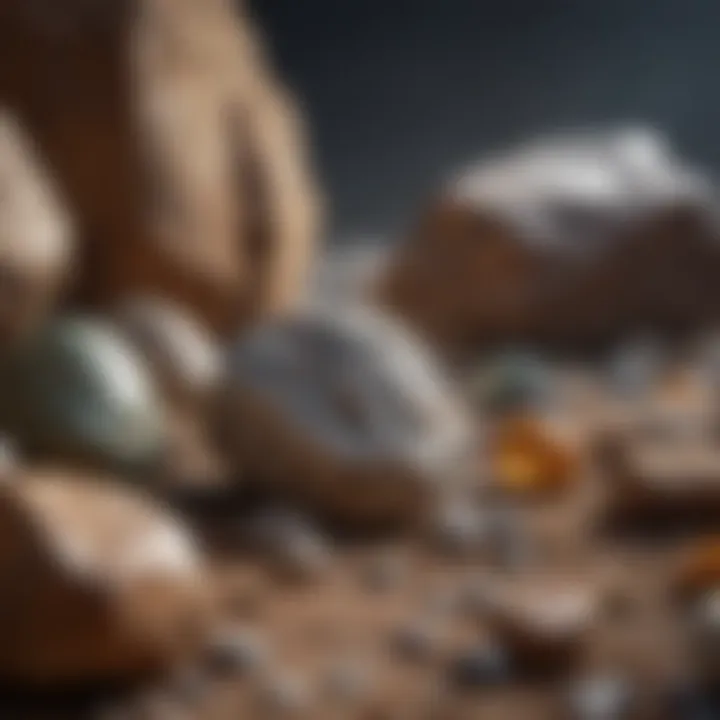
This crystallization process makes igneous rock a great starting point for collectors. Understanding these characteristics helps in identifying types based on texture and mineral composition, making igneous rocks a beneficial choice for beginners looking to hone their skills. Additionally, their durability makes them popular among those interested in jewelry-making, as they maintain their beauty over time.
Sedimentary Rock Features
Sedimentary rocks are formed from the consolidation of sediments, typically resulting from weathering of existing rocks or accumulation of organic materials. A striking feature of sedimentary rocks is their layered appearance, often revealing histories of environmental conditions over time. For instance, sandstone is indicative of ancient desert conditions, while limestone may point to marine environments.
This stratification serves as a natural storyteller about the Earth's history, with each layer holding clues to past climates, flora, and fauna. For collectors, sedimentary rocks offer a fascinating glimpse into the Earth's past, making them a must-have for those interested in temporal geography. Given their varied textures and often intricate fossils, sedimentary rocks invite inquiries about their origins and the changes they've undergone.
Metamorphic Rock Properties
Metamorphic rocks arise from existing rocks that have transformed due to intense heat and pressure over long periods. The most recognized characteristic of metamorphic rocks is foliation—a repetitive layering that occurs when pressure aligns minerals within the rock. Examples include slate, which originates from shale, and schist, which comes from mudstone.
Their formation highlights the profound changes rocks can undergo, illuminating the past environment and conditions that influenced their evolution. For collectors, metamorphic rocks provide a unique challenge, as identifying them requires attention to details like texture and mineral alignment. Their striking patterns and strength make them appealing not just for collecting but also for artistic applications.
Identifying Rocks
Identifying rocks is not just an academic pursuit; it's a doorway into understanding our planet's history. This section plays a crucial role in the bigger picture of rock and gem identification. When we delve into distinguishing various types of rocks, we unlock secrets about their formation, age, and the environmental conditions they underwent. Each rock tells its own tale, and knowing how to identify them adds layers of depth to our appreciation of geology.
For enthusiasts, understanding how to identify rocks can elevate a simple hobby into a more enriching experience. It encourages a hands-on approach, prompting collectors to observe and analyze the world around them with a critical eye. Plus, being able to distinguish between different rocks paves the way for better conservation techniques and respect for nature.
Physical Properties to Observe
Rocks may seem solid at first glance, but their true essence lies in a variety of observable physical properties. Let's break these down:
Color
Color is perhaps the most immediate attribute you notice when identifying a rock. It can range from deep blues to earthy browns. Color results from various factors, including mineral content and weathering processes. In this context, color plays a significant role in identification since certain minerals are known for specific hues.
- Key Characteristic: The vibrancy and consistency of color can indicate the presence of particular minerals.
- Benefits: A unique feature of color is its accessibility; anyone can observe it without needing advanced tools.
- Advantages/Disadvantages: However, color can be misleading. Two different minerals may present similar colors, which can lead to confusion without deeper analysis.
Texture
Texture refers to the feel and appearance of the rock’s surface. It can be rough, smooth, grainy, or even glassy. The texture is primarily a reflection of how quickly the rock cooled and crystallized or how it has weathered over time.
- Key Characteristic: A grainy texture typically indicates the rock has a significant amount of quartz or feldspar.
- Benefits: Understanding texture provides insights into the rock’s formation process and age.
- Advantages/Disadvantages: However, some rock types can appear deceptively similar in texture, which means it may not always be a straightforward identifier.
Weight
Weight is another vital factor to consider. Heavier rocks often contain denser minerals, while lighter rocks may have a higher volume of gas pockets or lighter materials.
- Key Characteristic: A rock's heft can signal specific mineral compositions, helping to narrow down identification.
- Benefits: This property is easily assessed in the field, especially when you are handling various specimens.
- Advantages/Disadvantages: Nevertheless, weight alone won't be sufficient for positive identification, particularly when comparing rocks with similar compositions.
Hardness
Hardness is often considered one of the most essential properties in identifying rocks. The Mohs hardness scale helps gauge a rock’s resistance to scratching, ranging from talc as the softest to diamond as the hardest.
- Key Characteristic: Knowing a rock's hardness can guide you to its mineral content.
- Benefits: It's a concrete method of identification, providing clear distinction among rock types.
- Advantages/Disadvantages: However, this requires tools, and the process needs to be carried out with care to avoid damaging the specimen.
Use of Tools for Rock Identification
When it comes to identifying rocks, having the right tools can make all the difference. Here are a few standard tools that can aid in the identification process:
Hand Lens or Magnifying Glass
Using a hand lens or magnifying glass is essential for any collector or enthusiast. This tool magnifies the details of the rock’s surface, allowing you to see its intricate features.
- Key Characteristic: It reveals minute details that are critical for identifying mineral compositions and textures in rocks.
- Benefits: The convenience of portability makes it an essential tool for fieldwork and outdoor rock hunting.
- Advantages/Disadvantages: While it enhances observation, relying solely on it can lead to overlooking other physical attributes unless combined with other methods.
Streak Plate
The streak plate is a handy tool that helps to ascertain the true color of a mineral in powdered form. By rubbing the rock on the streak plate, you can gather more information about its composition.
- Key Characteristic: This method allows you to see the underlying color that may not be visible in the raw rock.
- Benefits: It’s particularly useful for distinguishing between minerals with similar colors.
- Advantages/Disadvantages: However, not all rocks will produce a streak, which limits its utility in certain cases.
Hardness Kit
A hardness kit typically includes a set of tools used to test the hardness of different rock specimens. These kits often feature picks with various hardness ratings.
- Key Characteristic: It provides a systematic approach to testing and comparing multiple rocks.
- Benefits: By accurately gauging hardness, this tool helps to confirm suspicions about mineral content.
- Advantages/Disadvantages: Some novice collectors might find it challenging to use correctly without proper guidance.
Field Observations and Context
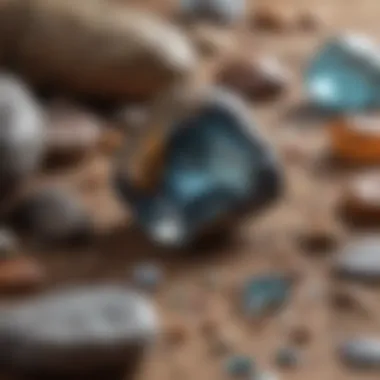
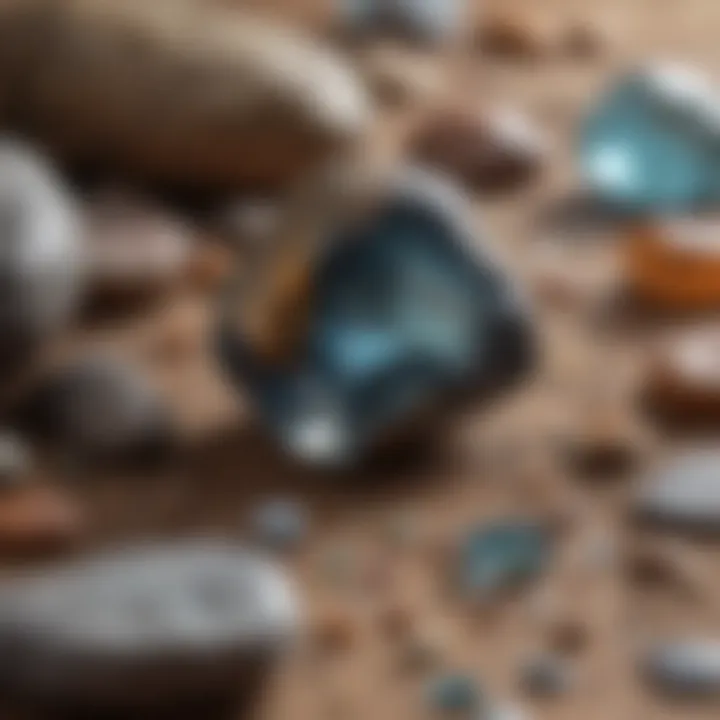
Understanding stones goes beyond physical properties and tools; context also matters. Observing where the rock is found—its environment—can provide you with clues for identification. Was it found in a riverbed, at a mining site, or on a mountain trail? Each setting hints at different geological processes that shaped the rock.
- For example, rocks found near volcanic areas may be igneous in nature, while those in sedimentary basins often have a different origin.
- Taking notes about the geologic features of the area can be hugely beneficial, as it connects the dots between the specimen and the circumstances of its formation.
This comprehensive set of guidelines on identifying rocks, focusing on their physical properties, tools, and contexts, sets a strong foundation for both novice and experienced rock and gem collectors. By diving into these aspects, enthusiasts can deepen their understanding of both rocks and the earth they come from.
Understanding Gems and Their Properties
Understanding gems and their properties is crucial for anyone involved in the identification and collection of rocks and gems. Gems, often characterized by their rarity and beauty, serve not just as adornments but also as symbols of status and wealth. This section digs into what sets these stones apart from regular minerals, elucidating their classification and optical characteristics. By embracing gemology, enthusiasts can refine their skills, enabling them to make informed decisions when selecting, purchasing, or appraising gems.
Gem Classification
Precious vs. Semi-precious Stones
The distinction between precious and semi-precious stones may initially seem trivial, yet it underscores a wealth of historical and commercial context. Precious stones — typically diamonds, rubies, sapphires, and emeralds — stand apart due to factors like rarity and societal allure. Their high demand often drives up their market value, making them the crown jewels of gem enthusiasts. On the flip side, semi-precious stones encompass a broad range, including garnets, amethysts, and opals.
These stones may not command the same prestige or price as precious ones but often boast vibrant colors and unique patterns that captivate collectors.
In our guide, the key characteristic of this classification lies not only in appearance but in market perception. Understanding these differences can shape your collecting strategy, influencing everything from how specimens are stored to their presentation in showcases.
Synthetic vs. Natural Gems
The growing conversation surrounding synthetic versus natural gems adds another layer of complexity to gemology. Synthetic gems, artificially created in labs, exhibit identical physical and chemical properties to their natural counterparts but often come at a fraction of the cost. This affordability makes synthetic options popular among casual collectors and jewelry enthusiasts. These stones can be excellent for those looking to indulge without breaking the bank.
However, the debate doesn’t end there. Natural gems, formed over millennia through geological processes, carry stories and histories that synthetic gems can never replicate. Collectors who value authenticity and heritage often shy away from synthetics for this reason. Deciphering these types is essential in realizing the true value behind any gem you wish to add to your collection.
Optical Characteristics of Gems
Color and Transparency
Color and transparency are paramount when identifying gems. Different minerals may share similar hues, but subtle variations can mark a world of difference. Take, for instance, the differences between an aquamarine and a blue topaz; each has a distinct appeal that often stuns gemologists and collectors alike. Transparency, on the other hand, tethers back to how light interacts with a gemstone; clarity may speak volumes about quality, influencing how light refracts within the stone.
Collectors often favor vibrant, translucent stones for their visual allure, while opaque gems like jade can tell a different story steeped in cultural significance. Navigating these attributes is essential, aiding collectors in selecting stones that resonate with both aesthetic appreciation and investment potential.
Cut and Clarity
Cut and clarity often dictate a gem's aesthetic qualities. The cut influences not only the shape but also the gem’s ability to reflect light. A well-cut gemstone can dazzle the eye, while a poorly cut one can appear less appealing, no matter its composition. When it comes to clarity, fewer inclusions or blemishes typically denote higher quality, raising a stone's desirability and value.
However, each collector has their nuances; some may prefer stones with unique internal features, partially due to a desire for originality. Thus, knowing how cut and clarity interplay can significantly enrich your gem identification process.
Refractive Index
The refractive index of a gemstone measures how much light bends as it passes through the stone, an important factor for gem identification. Each mineral exhibits a unique refractive index, making it a valuable trait to observe. For instance, diamonds are known for their exceptionally high refractive index, giving them their renowned sparkle.
On the contrary, some stones may possess a lower index but still amaze with their intrinsic beauty. This complex interplay can present both challenges and opportunities for collectors. Mastering the refractive properties of various gems can greatly enhance the efficacy of an identification endeavor.
Understanding how to navigate the melting pot of gem types extends beyond mere collection; it provides a lens through which one can discern the delicate nuances that each stone brings to the table, enriching the collection experience.
Practical Techniques for Identification
Identifying rocks and gems isn't merely a hobby; it's a nuanced art that demands certain practical techniques. These techniques serve as invaluable tools, helping enthusiasts differentiate between various specimens, understand their composition, and appreciate their unique beauty. Knowing how to measure, test, and consult reliable references can significantly elevate your collecting experience.
Conducting a Simple Test
Acid Test for Calcite
The Acid Test for Calcite is one of the simplest ways to identify this specific mineral. When a drop of dilute hydrochloric acid is placed on calcite, it reacts and bubbles, releasing carbon dioxide gas. This characteristic fizzing is a direct indicator of calcite's presence. The acid test is a favored choice because it's quick, easy, and can be conducted in any field setting with minimal tools.
However, there are a few things to keep in mind. The reaction might not be as pronounced with less concentrated acid, and this method should be used with care to avoid damaging the specimen or affecting surrounding materials. Its straightforward nature makes it an essential step in identifying sedimentary rocks that might contain calcite. The main upside here is that it offers immediate confirmation, while the downside could be the requirement for some safety precautions to handle acids.
Scratch Test for Hardness
The Scratch Test for Hardness is another primary method in rock and gem evaluation. This test is based on the Mohs scale of hardness, which categorizes minerals on a scale from 1 (talc) to 10 (diamond). A mineral’s hardness is determined by attempting to scratch it with various materials. For example, if a specimen can be scratched by a copper penny but not by a fingernail, it roughly falls within the 3 to 4 range on the Mohs scale.
It’s a popular choice among collectors because it helps in gauging how delicate or robust a mineral is, which can be crucial for both display and preservation. The unique feature of the Scratch Test lies in its low-cost simplicity; it requires no advanced tools, merely straightforward items you might have around the house. A downside is that some softer minerals might be easily damaged during the test, which can hinder future identification and appreciation.
Consulting Reference Materials
Field Guides
Field guides are an essential resource for rock and gem identification. These guides often detail local mineral types, their properties, and ideal conditions for finding them. A well-illustrated field guide can enhance outdoor scouting by allowing enthusiasts to recognize specimens right on the spot, making it easier to collect or photograph them.
These guides typically offer descriptions of texture, color, and other key characteristics, making them beneficial for both novices and seasoned collectors. One downside is that information may become outdated, so it is wise to verify data with recent studies or findings found online. However, the immediate utility and portability of field guides make them an attractive choice for any collector.
Online Databases
In the digital age, online databases have emerged as an invaluable tool for rock and gem enthusiasts. Websites like the Smithsonian National Museum of Natural History's mineralogy section or specific community databases on Reddit provide comprehensive insights into different specimens, including thumbnails and descriptions. These databases can be a collector’s best friend, offering information that may not be available in textbooks.
One standout feature of online databases is their ability to be updated regularly; they often reflect the latest research and findings in the field. Nevertheless, while they're rich in information, substantial knowledge of how to navigate these databases is required. Some may also contain vast amounts of information that can overwhelm beginners. Still, for those willing to learn to filter through, these resources can open a world of information.
Investing time in both practical testing and referencing materials can vastly improve one's skill set when it comes to identifying rocks and gems and undoubtedly adds depth to your personal collection.
Caring for and Preserving Collections

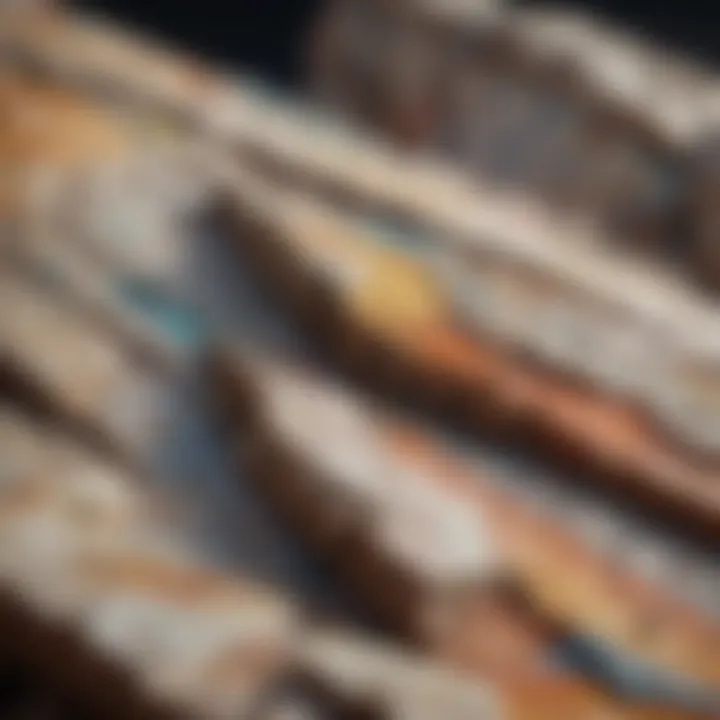
Caring for and preserving your rock and gem collection holds great significance, not only for the longevity of the specimens but also for the enjoyment and education they can provide. Whether one’s collection is a small assortment gathered during weekend hikes, or an extensive trove accumulated over the years, managing these treasures well makes all the difference. Proper care ensures that your geological finds remain vibrant, ready to impress, and informative over time.
As you delve deeper into the nuances of this practice, keep in mind that a well-maintained collection can tell a story about geological processes, historical context, and the environment from which these specimens originated. Thus, engaging with your collection through careful stewardship fosters an appreciation that transcends mere ownership.
Storage Solutions
Finding the right storage solutions is key. Many rock and gem collectors find themselves in a conundrum when it comes to organizing their specimens. Improper storage can lead to scratches, chips, or even chemical reactions that can degrade the quality of the materials over time.
Here are some essential tips on suitable storage:
- Display Cases: Using display cases can be a good way of showing off your collection while also offering protection from dust and physical damage. Look for cases with UV-filtering glass to prevent sun damage.
- Individual Containers: For smaller specimens, consider storing them in soft pouches or acid-free cardboard boxes. This prevents them from bumping into each other and getting damaged.
- Temperature and Humidity Control: A climate-controlled environment helps in preserving specimens, especially those sensitive to changes in temperature and moisture. Aim for a cool, dry place.
Using the right storage methods can drastically increase both the aesthetic and educational value of your collection, allowing it to be shared and admired for years to come.
Handling Techniques
How you handle your collection is just as important as where it is stored. Proper handling techniques help avoid unintentional damage to your rocks and gems. Here are a few strategies:
- Clean Hands: Before touching your specimens, make sure your hands are clean and dry. Oils and dirt can leave marks that are hard to remove and can diminish the specimen's value.
- Use Gloves: For more delicate or precious pieces, wearing cotton gloves adds a layer of protection. This simple step can prevent scratches that may occur when handling with bare hands.
- Hold with Care: When lifting rocks or gems, always support them from the bottom rather than from the sides. This minimizes the risk of dropping them or applying pressure to vulnerable points.
"A little bit of care goes a long way in preserving the stories of the earth housed within your collection."
By incorporating these practices into your routine, you can create a sanctuary for your collection that enhances its intrinsic values while safeguarding its precious features. Collecting is more than a hobby; it’s a journey through time, the Earth, and a reflection of one’s curiosity about nature.
The Community of Collectors
Building a community around rock and gem collecting is not just important; it often defines the collecting experience itself. Being a part of this community makes the journey richer and more fulfilling. You could find yourself in a group of like-minded individuals who share the same passion and enthusiasm for the intriguing world of minerals. This sharing of knowledge can solidify your understanding and might even lead you to some rare finds.
Finding Fellow Enthusiasts
Clubs and Organizations
Many local clubs and organizations devoted to rock and gem collecting provide a platform for enthusiasts to connect, learn, and grow. Joining such clubs can be a beneficial choice; they often host meetings, field trips, and workshops. For instance, attending a club meeting may open doors to hands-on learning experiences. There's a sense of community in these gatherings, where you can swap tips and stories with people who share your fascination.
One of the most valued aspects of these organizations is the access to veteran collectors. Their insights can save you from common pitfalls in identifying rocks and gems, allowing you to fast-track your learning. Similarly, many clubs encourage group outings to local quarries or gem shows, which can be quite advantageous. Just imagine digging alongside experts!
However, not everything is rose-colored. Some clubs might have membership fees or require a commitment of time, which could deter newcomers. It’s crucial to weigh the costs and benefits before diving in.
Online Forums
In today's digital age, online forums have become golden nuggets for collectors. They bring together individuals from all walks of life, providing an accessible platform for discussions about identification techniques, recent finds, and even market trends. Sites like reddit.com have specific communities dedicated to rock and mineral collecting where you can ask questions or simply lurk and learn.
A key characteristic of online forums is the immediacy of information. Users post questions and receive real-time feedback, allowing you to gain different perspectives on your inquiries. Plus, many of these forums are free to join, making them an inviting choice for those hesitant to commit to physical clubs. Not to mention, the diverse backgrounds of members can offer refreshing insights that you might not encounter at a local club.
However, it's essential to verify the credibility of the information shared online. Not every post may be accurate, and sometimes, opinions can be sharply divided. This variety adds a layer of complexity and can lead to misinformation if one is not careful.
Sharing Knowledge and Resources
Engaging with fellow collectors also equips you to contribute knowledge and resources back into the community. Whether sharing identification tools, collecting methods, or geological understanding, the cycle of information sharing enhances everyone’s experience. Collectors can exchange field notes, reference materials, and even trade specimens with one another. This practice of sharing not only fosters camaraderie but also nurtures a culture of continuous learning.
In summary, being a part of the community of rock and gem enthusiasts enriches your collecting journey, providing both knowledge and companionship. From clubs and organizations that promote hands-on experience to online forums that offer timely discussions, each avenue offers unique benefits and challenges. By participating in these communities, you enhance your identification skills and possibly deepen your appreciation for nature’s hidden gems.
Closure
In wrapping up our journey through the world of rock and gem identification, it’s clear that this endeavor holds significant value for any enthusiast eager to deepen their understanding and appreciation. Engaging in the classification of both rocks and gems is not merely a passing hobby; it’s a lifelong pursuit that fosters curiosity and an appreciation for the earth's complexities.
The Lifelong Journey of Collecting
The lure of collecting is often tied to discovery. As you delve into identifying a new specimen, you find not just a rock or a gem, but a piece of history, shaped by natural forces over millennia. Each collection tells a story—of volcanic eruptions, glacial actions, or sediment deposits, offering insights that textbooks can't fully capture. As you curate your stash, every new find adds to the narrative, providing context that enriches your experience and knowledge.
Those who embrace the challenge often develop a keen eye for both the beauty and the science behind each specimen. The act of searching, whether you're wandering through forests, hiking mountains, or visiting gemstone shows, is where the thrill resides. You become part of a larger narrative, connecting with an age-old practice where people marveled at the wonders nature offers.
Encouragement for Continuous Learning
In an age overwhelmed by information, pushing past the initial stages of learning about rocks and gems can feel daunting. However, it's crucial to embrace the idea that learning doesn't stop once you gather a handful of specimens. Continuous education opens pathways to deeper recognition and understanding.
Consider utilizing various resources:
- Field Guides: Essential for easily identifying common rocks and gems.
- Online Courses: Many platforms offer detailed courses focused on geology and gemology.
- Communities for Collectors: Forums and clubs can lead to knowledge sharing and experience exchange.
The more you explore, the more you unveil the interplay of geology and mineralogy. Keep in mind that even the simplest rock can hide complex details that only a trained eye can appreciate.
Embrace social media, leverage platforms like Reddit to discuss findings and ask questions. Learning from fellow enthusiasts can be incredibly enriching. It’s not just about what you gather, but how those collections interact with an ever-growing pool of knowledge respected by peers.
As the saying goes, "the more you know, the more you realize you don’t know." This belief enhances your collecting experience, allowing it to be as much about the journey as the destination.
Continuous learning in rock and gem identification nurtures a profound respect for nature’s work.



